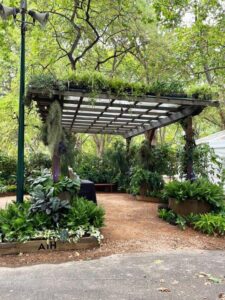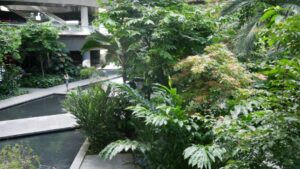
Shade and tree coverage, critical amid rising urban heat
By Michael Casey
The World Meteorological Organisation (WMO) confirmed 2023 was the warmest year on record. The annual average global temperature in 2023 was close to 1.5°C above pre-industrial levels, a significant benchmark set by the Paris Agreement to limit long-term temperature increases.
According to six leading international datasets consolidated by the WMO, the average global temperature in 2023 was 1.45 ± 0.12°C above pre-industrial levels (1850-1900). With urbanisation rapidly transforming landscapes across the globe, often at the expense of natural vegetation, this shift to warmer temperatures is contributing to a phenomenon known as the urban heat island (UHI) effect, where urban areas experience significantly higher temperatures than their rural counterparts.
Southeast Asia and Australia are particularly affected by this issue due to their unique climatic conditions and rapid urban development, with poorer communities suffering the most. This article explores the impacts of urban heat and the importance of shade and tree coverage, while providing examples from Southeast Asia and Australia to highlight effective strategies and initiatives.

Urban Heat Islands (UHI) occur when natural landscapes are replaced with concrete, asphalt, and buildings which absorb and retain heat. The lack of vegetation exacerbates this effect, leading to higher daytime temperatures, reduced night-time cooling, and overall warmer urban environments. The consequences of UHI are far-reaching, including increased energy consumption, elevated emissions of air pollutants and greenhouse gases, and adverse health effects on urban populations, especially outdoor workers.
Trees and vegetation play a critical role in mitigating the UHI effect. They provide shade, which directly cools surfaces and reduces ambient temperatures, especially on roads and footpaths where people commute. Additionally, through the process of transpiration, trees release moisture into the air, further cooling the environment. Green spaces also improve air quality, enhance urban aesthetics, and support biodiversity. Trees pose a very impressive solution to cooling our cities, but why are our streets barren of tall shading specimens, and what do we need to do to bring plants back into our built environment?
Who is most at risk during severe heat events? We all are, whether it be health effects or financial strain. A warming environment costs us all through increased use of utilities such as electricity, and water to cool our houses and water our gardens. Economic damage also occurs when our electricity grids cannot withstand long-term peak demands, and our transport systems literally come to a halt, with trains affected on hotter days. It has been widely publicised in major cities that trains will be slowed down due to the expansion of steel tracks in hotter weather. Other factors affecting commuting and delivery of supplies include road networks that can be adversely affected when bitumen melts on highly used roads. Slowing down the way we move around cities and the congestion it brings is a major economic disaster when the heat lasts for days or even weeks.
The health effects are numerous, and the most vulnerable are often the most affected. People living below the poverty line may not be able to afford cooling or the costs of running cooling systems and are often exposed to unhealthy temperatures inside their homes. Some communities are now looking at ways of setting up emergency heat evacuation zones, where places are provided to allow people to enjoy cooler conditions. My company is closely associated with a Melbourne suburb where we are also addressing the outside of their evacuation centre and planting an array of trees to mature into shade-bearing canopies so people can also use the outdoor spaces.
How do outdoor workers prepare for a hotter summer period? Recent temperatures in India observed averages between 28 and 32 degrees Celsius at night and up to the mid-40s during the day. The relentless heat is significantly impacting outdoor workers’ health. A new report by the International Labour Organization (ILO) warns that over 70% of workers worldwide are at risk of exposure to excessive heat, threatening their safety and health. This affects more than 2.4 billion workers out of a global workforce of 3.4 billion.

In Australia, along with other countries around the world, we need to understand the implications of excessive heat and its effects on work output, as heat significantly reduces worker productivity. The New South Wales treasury estimates that by 2061, the state could lose up to 2.7 million working days annually in agriculture, construction, manufacturing, and mining due to heat-related impacts.
How do sole-traders, contractors and larger companies working in outdoor environments manage heat and plan their time around hotter parts of the day while remaining economically viable? Many small-scale contractors are now starting to factor in extreme heat variation costs into their working contracts, which unfortunately can push additional costs back to the client. For example, some outdoor companies I have worked alongside are implementing an early start and finish schedule, working from 5am to 1pm to avoid the peak afternoon heat. Additionally, they are investing in portable shade structures and cooling equipment to ensure their workers can take frequent breaks in a cooler environment. These measures, while effective, come at a cost. The businesses will need to adjust their pricing to account for the additional resources and altered working hours, along with communicating transparently to clients as a necessary step to ensure worker safety and project quality under increasingly extreme weather conditions. This proactive approach highlights the need for clients to understand and support the additional costs associated with adapting to climate change impacts.
Across Southeast Asia and Australia, initiatives are underway to combat the UHI effect through strategic greening efforts. The City of Melbourne has implemented an Urban Forest Strategy to combat the UHI effect. The strategy involves planting 3,000 trees annually, with a goal to increase canopy cover from 22% to 40% by 2040. This initiative not only addresses heat but also aims to create a more resilient and sustainable urban environment, enhancing the city’s capacity to adapt to climate change and deal with heat.
Western Sydney is one of the hottest areas in the city, experiencing extreme temperatures during summer. The New South Wales government has launched the “Greening the West” initiative, which aims to plant five million trees by 2030. This ambitious project seeks to increase tree canopy cover, reduce heat stress, and improve the overall livability of the region.
In the tropical regions, Singapore, known as the “Garden City”, has long recognised the importance of greenery in urban areas. The city-state has implemented extensive greening policies, including the planting of roadside trees, rooftop gardens, and vertical greenery on buildings. The “Skyrise Greenery” initiative encourages the incorporation of plant life in high-rise developments, which helps combat the UHI effect and enhances urban living conditions.
Bangkok faces significant UHI challenges due to its dense urban fabric and tropical climate. To address this, the Bangkok Metropolitan Administration (BMA) has focused on increasing urban green spaces. One notable example is the creation of Benjakitti Park, which features extensive tree coverage, water bodies, and open spaces. This park not only provides recreational opportunities but also helps mitigate the urban heat effect in the surrounding areas.

Indonesia is implementing various greening initiatives to alleviate urban heat, including increasing green spaces in Jakarta, adopting vertical gardens and green roofs in Surabaya, establishing urban forests in Bandung, and restoring mangroves in coastal cities like Semarang. The government’s “Green City Development Program” encourages sustainable urban planning, and cities like Medan and Yogyakarta have launched extensive tree planting campaigns. These efforts aim to reduce heat, improve air quality, and enhance urban resilience.
Recently, the Australian Institute of Horticulture, along with the Cancer Institute of NSW, launched the Shade Smart program at the Melbourne International Flower and Garden Show. The detailed design highlighted greening solutions to emphasise the program’s design solutions that have been compiled for landscape architects and other built environment professionals to improve awareness and understanding of high-quality shade design for UV and heat protection. The garden, visited by many at the garden show, demonstrated the ease of shading residential properties.
The urban heat island (UHI) effect presents significant challenges to cities worldwide, particularly in Southeast Asia and Australia. These regions are implementing strategic green infrastructure solutions to mitigate UHI impacts. Initiatives like Singapore’s Skyrise Greenery, Bangkok’s urban parks, Sydney’s Greening the West, and Melbourne’s Urban Forest Strategy highlight the critical role of shade and tree coverage in reducing urban heat, improving air quality, and enhancing urban life quality. As urbanisation accelerates, these efforts are increasingly vital in creating sustainable and livable cities, addressing both the environmental and socio-economic impacts of rising temperatures.
Michael Casey
Director, Evergreen Infrastructure,
Consultant/Advisor to Green infrastructure industry &
Technical Panel for AIPH World Green Cities Awards 2024
E: michael@evergreeninfrastructure.com.au
